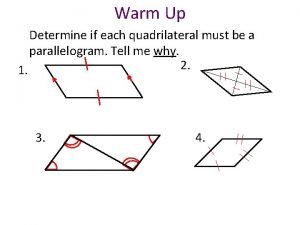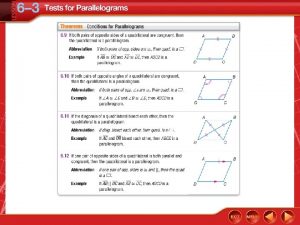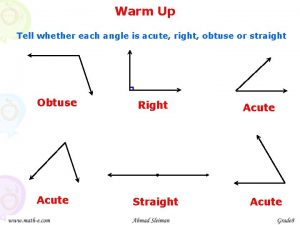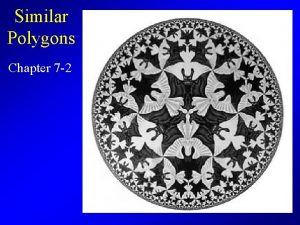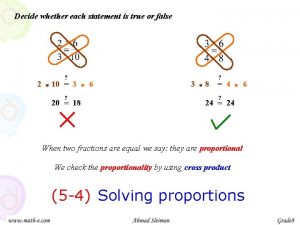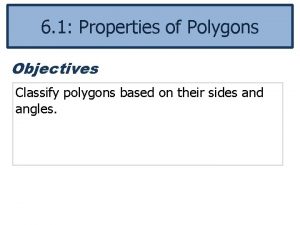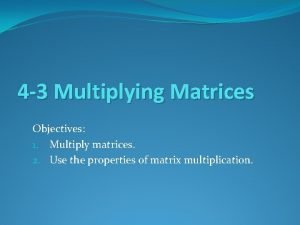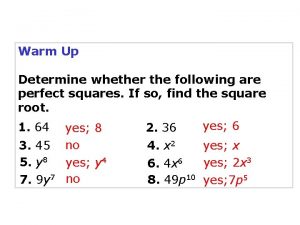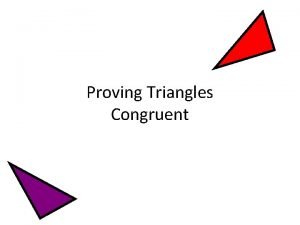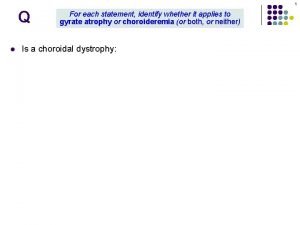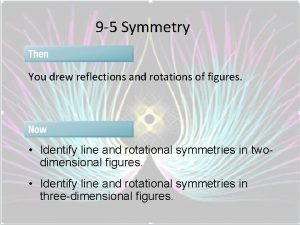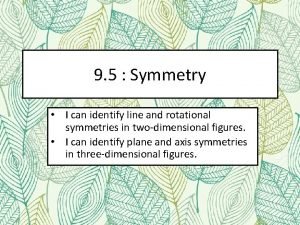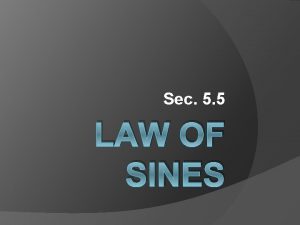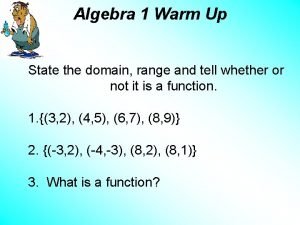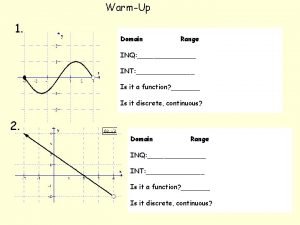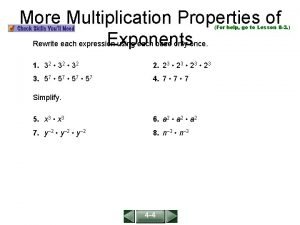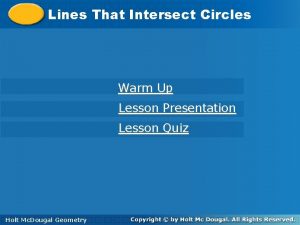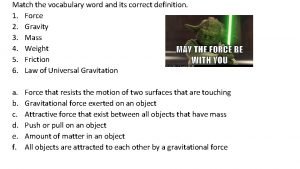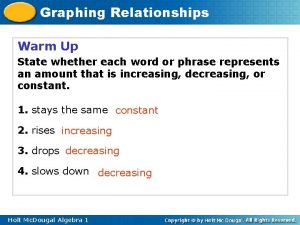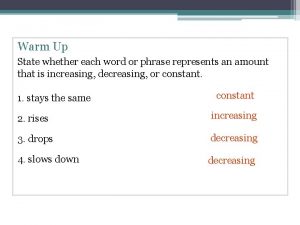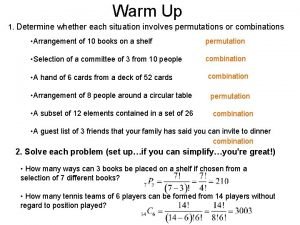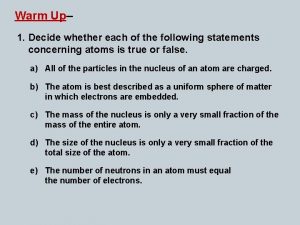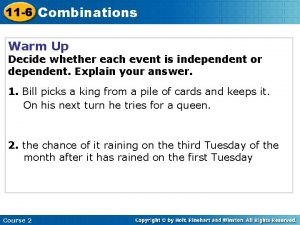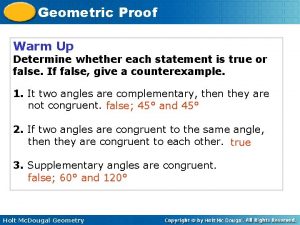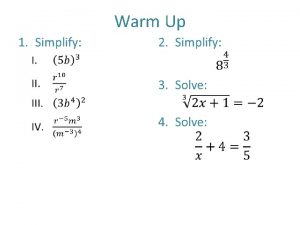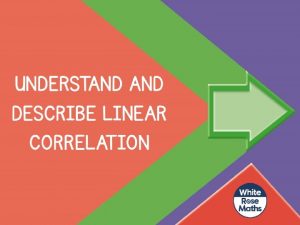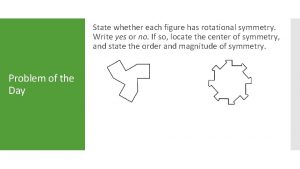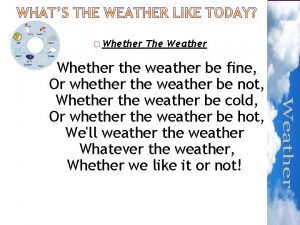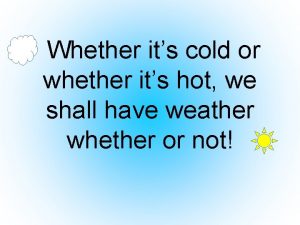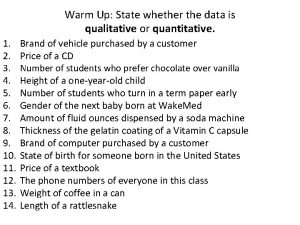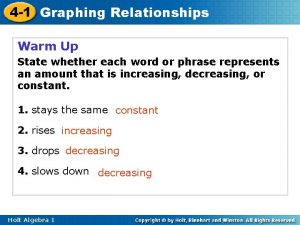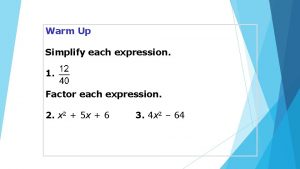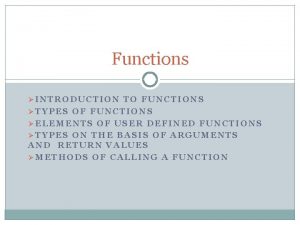Introduction to Functions Warm Up State whether each































- Slides: 31

Introduction to Functions

Warm Up State whether each word or phrase represents an amount that is increasing, decreasing, or constant. 1. stays the same constant 2. rises increasing 3. drops decreasing 4. slows down decreasing

Functions & Relations

Objectives • Match simple graphs with situations. • Graph a relationship. • Identify functions. • Find the domain and range of relations and functions. Vocabulary continuous graph discrete graph relation domain range function

Example 1 The air temperature increased steadily for several hours and then remained constant. At the end of the day, the temperature increased slightly before dropping sharply. Choose the graph that best represents this situation. Step 1 Read the graphs from left to right to show time passing.

Helpful Hint When sketching or interpreting a graph, pay close attention to the labels on each axis.

Sketching Graphs for Situations Sketch a graph for the situation. Tell whether the graph is continuous or discrete. A small bookstore sold between 5 and 8 books each day for 7 days. The number of books sold (y-axis) varies for each day (x-axis). Since the bookstore accounts for the number of books sold at the end of each day, the graph is 7 distinct points. The graph is discrete.

You have seen relationships represented by graphs. Relationships can also be represented by a set of ordered pairs called a relation. In the scoring systems of some track meets, for first place you get 5 points, for second place you get 3 points, for third place you get 2 points, and for fourth place you get 1 point. This scoring system is a relation, so it can be shown by ordered pairs. {(1, 5), (2, 3), (3, 2) (4, 1)}. You can also show relations in other ways, such as tables, graphs, or mapping diagrams.

Graphs can be used to illustrate many different situations. For example, trends shown on a cardiograph can help a doctor see how a patient’s heart is functioning. To relate a graph to a given situation, use key words in the description.

Showing Multiple Representations of Relations Express the relation {(2, 3), (4, 7), (6, 8)} as a table, as a graph, and as a mapping diagram. 2 3 4 7 6 8 Write all x-values under “x” and all y-values under “y”.

Continued Express the relation {(2, 3), (4, 7), (6, 8)} as a table, as a graph, and as a mapping diagram. Graph Use the x- and y-values to plot the ordered pairs. Vertical Line Test?

Continued Express the relation {(2, 3), (4, 7), (6, 8)} as a table, as a graph, and as a mapping diagram. Mapping Diagram x y 2 3 4 7 6 8 Write all x-values under “x” and all y-values under “y”. Draw an arrow from each xvalue to its corresponding yvalue.

Try This! Express the relation {(1, 3), (2, 4), (3, 5)} as a table, as a graph, and as a mapping diagram. Table x y 1 3 2 4 3 5 Write all x-values under “x” and all y-values under “y”.

Try This! Continued Express the relation {(1, 3), (2, 4), (3, 5)} as a table, as a graph, and as a mapping diagram. Graph Use the x- and y-values to plot the ordered pairs.

Try This! Continued Express the relation {(1, 3), (2, 4), (3, 5)} as a table, as a graph, and as a mapping diagram. Mapping Diagram x y 1 3 2 4 3 5 Write all x-values under “x” and all y-values under “y”. Draw an arrow from each x-value to its corresponding y-value.

The domain of a relation is the set of first coordinates (or x-values) of the ordered pairs. The range of a relation is the set of second coordinates (or y-values) of the ordered pairs. The domain of the track meet scoring system is {1, 2, 3, 4}. The range is {5, 3, 2, 1}.

Try This! Give the domain and range of the relation. 6 5 2 1 – 4 – 1 0 The domain values are all x-values 1, 2, 5 and 6. The range values are y-values 0, – 1 and – 4. Domain: {6, 5, 2, 1} Range: {– 4, – 1, 0}

Try This! Give the domain and range of the relation. x y 1 1 4 4 8 1 The domain values are all x-values 1, 4, and 8. The range values are y-values 1 and 4. Domain: {1, 4, 8} Range: {1, 4}

A Function is a special type of relation that pairs each domain value with EXACTLY ONE range value.

Identifying Functions Give the domain and range of the relation. Tell whether the relation is a function. Explain. {(3, – 2), (5, – 1), (4, 0), (3, 1)} D: {3, 5, 4} R: {– 2, – 1, 0, 1} Even though 3 is in the domain twice, it is written only once when you are giving the domain. The relation is not a function. Each domain value does not have exactly one range value. The domain value 3 is paired with the range values – 2 and 1.

Identifying Functions Give the domain and range of the relation. Tell whether the relation is a function. Explain. – 4 – 8 4 5 2 1 Use the arrows to determine which domain values correspond to each range value. D: {– 4, – 8, 4, 5} R: {2, 1} This relation is a function. Each domain value is paired with exactly one range value.

Try This! Give the domain and range of each relation. Tell whether the relation is a function and explain. a. {(8, 2), (– 4, 1), (– 6, 2), (1, 9)} b. D: {– 6, – 4, 1, 8} R: {1, 2, 9} The relation is a function. D: {2, 3, 4} Each domain value is R: {– 5, – 4, – 3} paired with exactly one The relation is not a function. range value. The domain value 2 is paired with both – 5 and – 4.

Relations and Functions Relation: a set of ordered pairs. {(3, 2), (– 1, 5), (0, 2)} Domain: all of the x values or inputs {3, – 1, 0} Range: all of the y values or outputs {2, 5, 2}

Function: a relation in which each element of the domain is paired with exactly one element of the range. Are the following relations also functions? Ex. {(2, 3), (– 1, 4), (4, 5), (– 2, 3)} Yes, each element of the domain is paired with 1 element of the range. Ex. {(4, 4), (– 2, 3), (4, 2), (3, 4)} No, 4 in the domain is paired with 2 different outputs.

Mapping: illustration of how domain and range are paired: Ex: Map the relation {(2, 3), (– 1, 4), (0, 0), (3, 9), (1, – 4)} 2 – 1 0 3 1 3 4 0 9 – 4 domain range input output

Example: Which mapping represents a function? a. b. 3 1 0 – 1 2 3 Yes 2 – 1 3 2 3 – 2 0 No, – 1 is paired with two elements of the range

Vertical Line Test: a relation is a function if a vertical line drawn through its graph, passes through only one point. Example: Do the following graphs represent functions? hits only once This graph represents a function hits twice This graph is not a function

Evaluating functions: Example: If f(x) = 3 x – 1, find f(5) “f of x” is a function. Find “f of 5”. f(5) = 3(5) – 1 substitute 5 for x = 15 – 1 therefore, f(5) = 14

Example: If g(x) = 3 x 2 – 2 x find g(– 2) Substitute – 2 for each x g(– 2) = 3(– 2)2 – 2(– 2) = 3(4) + 4 = 12 + 4 g(– 2) = 16

• Domain and Range • Discrete vs. Continuous Functions

Homework • Practice Worksheet • Final Review – Due at the Final Exam
 State whether each quadrilateral is a parallelogram
State whether each quadrilateral is a parallelogram How to determine whether a quadrilateral is a parallelogram
How to determine whether a quadrilateral is a parallelogram Read each of the following situations
Read each of the following situations Whether the weather be fine
Whether the weather be fine Angles name
Angles name Similar polygons
Similar polygons Decide whether each statement is true or false
Decide whether each statement is true or false Judicial restraint clipart
Judicial restraint clipart Properties of polygons
Properties of polygons Multiplying and dividing matrices
Multiplying and dividing matrices Determine whether each trinomial is a perfect square
Determine whether each trinomial is a perfect square Decide whether each group of words is an independent clause
Decide whether each group of words is an independent clause Write whether each
Write whether each Decide whether each group of words is an independent clause
Decide whether each group of words is an independent clause Congruence postulate
Congruence postulate Determine whether each word
Determine whether each word Identify whether each statement
Identify whether each statement State whether the figure appears to have line symmetry
State whether the figure appears to have line symmetry Plane and axis symmetry
Plane and axis symmetry State whether the given measurements determine zero
State whether the given measurements determine zero Domain and range warm up
Domain and range warm up What is the domain and range of the function
What is the domain and range of the function Rewrite each expression with rational exponents.
Rewrite each expression with rational exponents. Identify each line or segment that intersects each circle
Identify each line or segment that intersects each circle Contracting state meaning in aviation
Contracting state meaning in aviation Order of rotation of hexagon
Order of rotation of hexagon State the excluded values for each rational expression
State the excluded values for each rational expression In primitive flow table for gated latch each state has
In primitive flow table for gated latch each state has Match the vocabulary word with its meaning
Match the vocabulary word with its meaning 2 properties of liquids
2 properties of liquids State to state regionalism
State to state regionalism S r flip flop excitation table
S r flip flop excitation table
